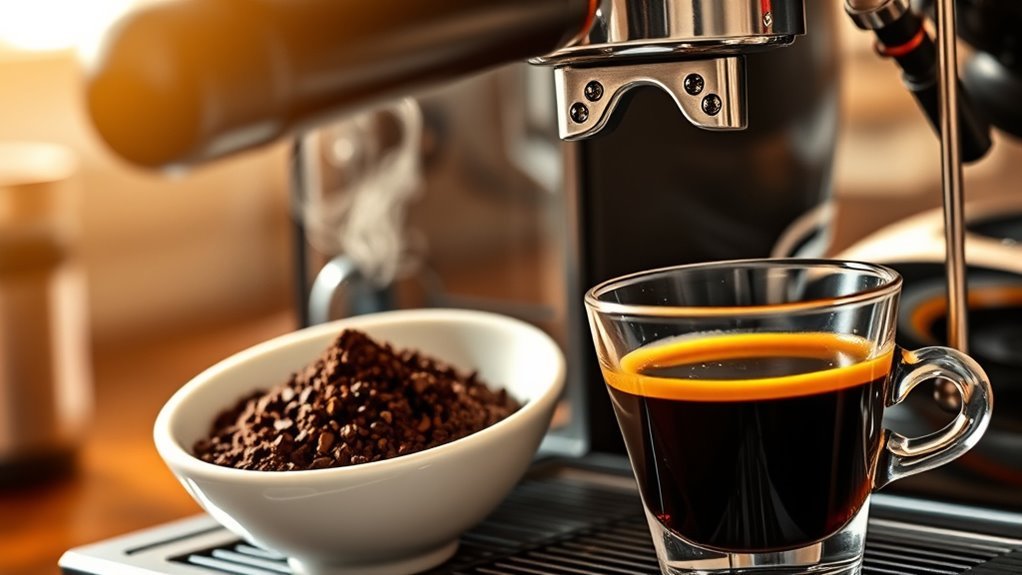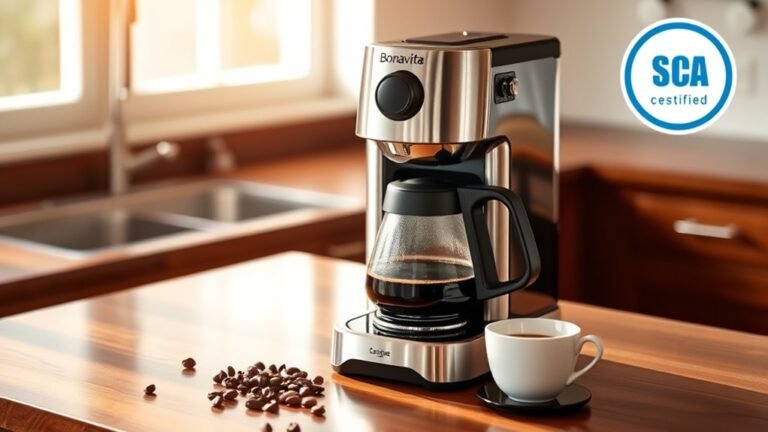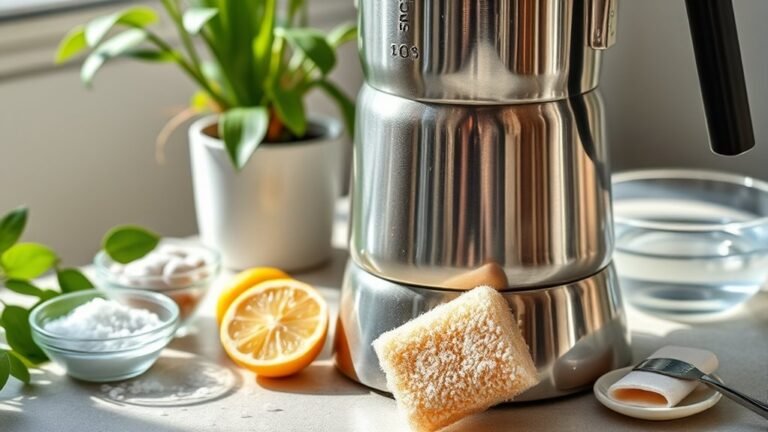Can You Put Regular Coffee Grounds in an Espresso Machine
Using regular coffee grounds in an espresso machine isn’t advisable. The coarser grind may lead to under-extraction or over-extraction, resulting in a milder flavor profile and less crema. Espresso requires finely-ground coffee for ideal pressure and extraction, while regular grounds can clog the machine and compromise performance. Plus, you might find the flavor lacking compared to traditional espresso blends. There’s much more to take into account about grind size, flavor impact, and maintenance that you’ll want to explore further.
Understanding Espresso and Its Unique Requirements
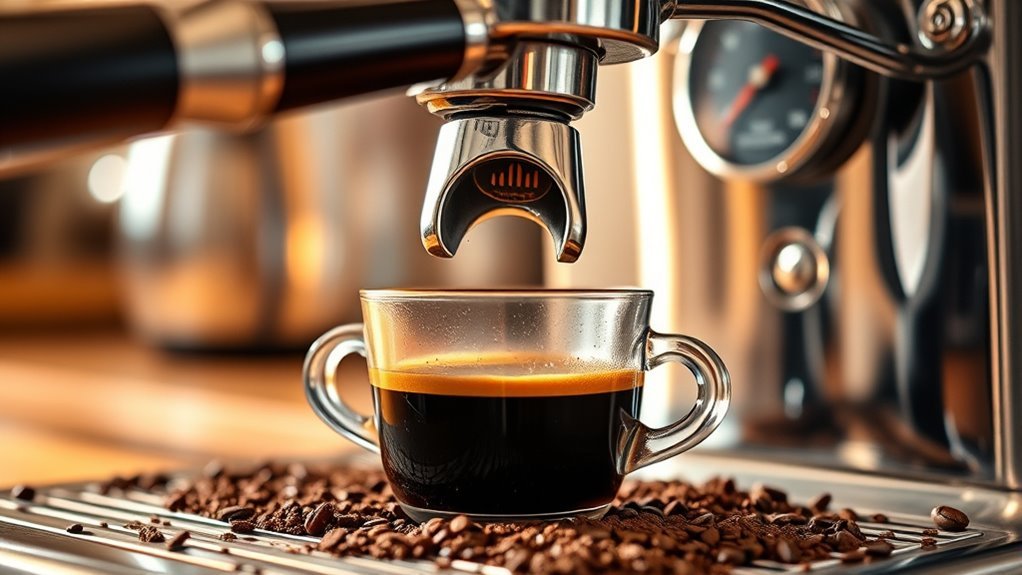
When you consider brewing espresso, it’s essential to understand its unique requirements, as these factors greatly influence the final cup. Espresso extraction demands specific brewing techniques that are distinct from regular coffee preparation. The process involves forcing hot water through finely-ground coffee under high pressure, which allows for a rich, concentrated flavor profile. You’ll need to pay close attention to variables like grind size, water temperature, and extraction time. Each of these elements plays a vital role in achieving the perfect shot. Regular coffee grounds simply won’t yield the same results, as they’re typically coarser and designed for different brewing methods. By mastering these requirements, you can embrace the freedom that comes with crafting an exceptional espresso experience.
The Difference Between Espresso and Regular Coffee
Espresso and regular coffee differ greatly in their brewing methods, flavor profiles, and even the types of beans used. Espresso extraction involves forcing hot water through finely-ground coffee at high pressure, resulting in a concentrated shot with a rich crema on top. This process emphasizes the coffee flavor, enhancing the natural oils and sugars in the beans, which creates a bold, complex taste. In contrast, regular coffee typically employs a drip or pour-over method, using coarser grounds and longer brewing times, leading to a milder flavor profile. The beans used for espresso are often darker roasted, providing a different taste experience compared to the lighter roasts commonly found in regular coffee. Understanding these distinctions helps you appreciate each beverage’s unique characteristics.
Can You Use Regular Coffee Grounds in an Espresso Machine?
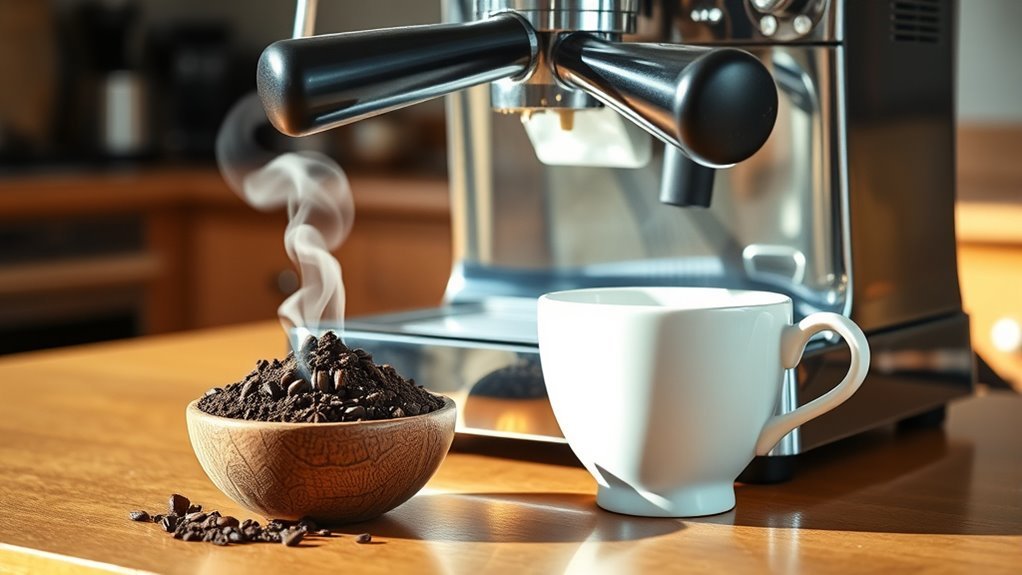
You might wonder if regular coffee grounds can be used in your espresso machine, but it’s not as straightforward as it seems. The grind size of the coffee greatly affects extraction, and using the wrong texture can lead to suboptimal flavor profiles and potential machine compatibility issues. Understanding these factors is essential for achieving the best possible espresso experience.
Espresso Grind Size
The grind size of coffee plays an essential role in the brewing process, particularly for espresso machines. For ideal espresso extraction techniques, you need a fine grind, which allows for the right amount of surface area to enhance extraction. Using regular coffee grounds, typically coarser, compromises grind size importance and can lead to under-extraction or over-extraction, resulting in undesirable flavors. The pressure and temperature of espresso machines require a precise grind to achieve that rich, concentrated shot you crave. If you want freedom in your coffee experience, invest in a burr grinder to guarantee consistency. This way, you can explore various beans while maintaining the grind size necessary for perfect espresso shots every time.
Flavor Profile Differences
How do flavor profiles shift when using regular coffee grounds in an espresso machine? When you opt for regular coffee grounds, the resulting espresso can greatly differ in coffee flavor. These grounds typically yield a brew that’s less intense and lacks the rich, concentrated notes expected from finely ground espresso. The brewing techniques employed in espresso extraction—high pressure and precision timing—require a specific grind size to achieve ideal flavor extraction. With coarser grounds, you may encounter under-extraction, leading to sour or weak flavors, while over-extraction can introduce bitterness. Ultimately, using regular coffee grounds can dilute your espresso experience, making it essential to understand how grind size directly influences the final cup’s taste.
Machine Compatibility Issues
While it might seem convenient to use regular coffee grounds in an espresso machine, compatibility issues often arise. Espresso machines are designed for finely ground coffee, typically requiring a specific grind size for ideal extraction. Using coarser grounds can lead to under-extraction, resulting in a weak shot, while finer grounds may cause over-extraction, leading to bitterness. You’ll need to make precise grind adjustments to achieve the right consistency, which might not be feasible with pre-ground coffee. Additionally, some espresso machines may struggle with regular grounds, potentially clogging the brew head or affecting pressure. Ultimately, understanding your machine’s compatibility with different grind sizes is essential for crafting a quality espresso experience.
Impact on Flavor and Quality
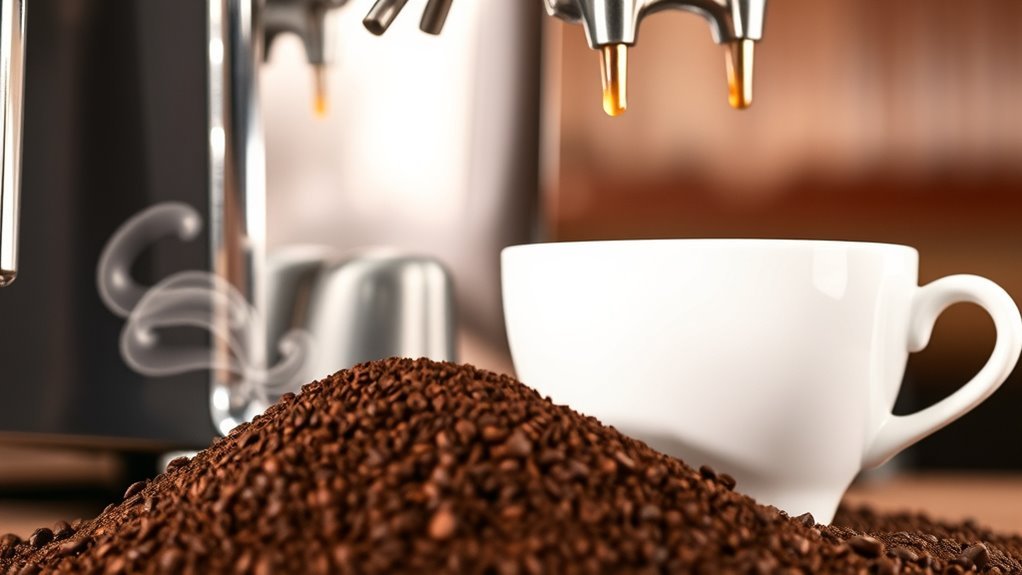
Using regular coffee grounds in your espresso machine can greatly alter the flavor profile of your brew. The extraction process differs due to the grind size and roast level, impacting the overall quality and richness of the shot. Understanding these changes is essential for achieving the desired taste and consistency in your espresso.
Flavor Profile Differences
When exploring the flavor profile differences between regular coffee grounds and espresso blends, you’ll notice significant variations that can impact the overall quality of your brew. Regular coffee grounds often provide a milder flavor intensity, lacking the boldness that espresso aficionados seek. Espresso blends are crafted with specific brewing techniques in mind, allowing for ideal extraction of rich, complex notes. The finer grind of espresso enhances these flavors, resulting in a concentrated shot with a full-bodied taste. In contrast, using regular grounds can lead to a diluted flavor, compromising the experience. If you’re after the vibrant, nuanced flavors typical of espresso, sticking to specially formulated blends is essential for achieving that desired intensity and quality in your cup.
Extraction and Brew Quality
Although you might think that any type of coffee ground can yield a decent espresso, the extraction process is essential for achieving perfect flavor and quality. Regular coffee grounds often result in uneven extraction, compromising brew consistency and flavor clarity. When using espresso-specific grounds, the finer grind allows for superior extraction techniques, enhancing the richness and complexity of your shot.
| Extraction Technique | Regular Grounds | Espresso Grounds |
|---|---|---|
| Grind Size | Coarse | Fine |
| Brew Time | Inconsistent | Precise |
| Flavor Profile | Muddled | Rich and Bold |
Investing in the right grind guarantees you enjoy a liberating espresso experience, free from the pitfalls of subpar extraction.
Grind Size: Why It Matters
Grind size plays a crucial role in the extraction process of espresso, directly influencing flavor and strength. When you use the right grind consistency, it guarantees peak brew efficiency. A fine grind allows for a faster extraction, pulling out rich flavors, while a coarser grind can lead to under-extraction, resulting in a sour taste. If you’re using regular coffee grounds, you’ll likely find inconsistencies that can hinder your espresso experience. The key is to aim for a uniform grind that matches the machine’s requirements, enhancing the overall taste. Remember, achieving the perfect espresso isn’t just about the coffee itself; it’s about how you prepare it. So, pay attention to grind size to elevate your espresso game.
Tips for Using Regular Coffee Grounds in Espresso Machines
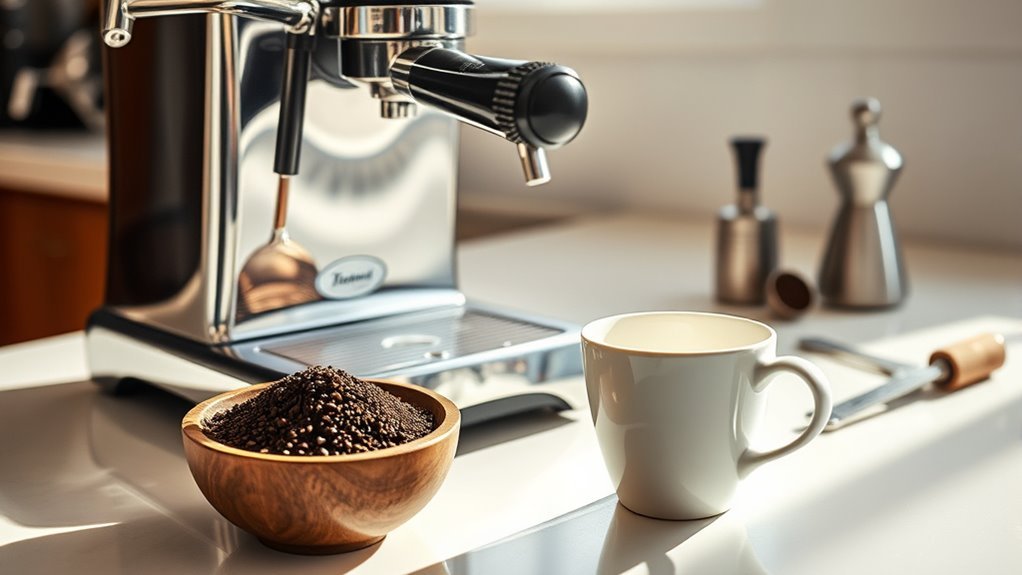
Using regular coffee grounds in an espresso machine can be a challenge, especially if you’re aiming for that perfect shot. To enhance your espresso brewing experience, start by adjusting the dose; use about 14-18 grams for a double shot. Since regular coffee grounds are typically coarser, you may need to experiment with the tamping pressure to guarantee proper coffee extraction. A firmer tamp can help achieve a better seal, but don’t go overboard. Pay attention to your brewing time; aim for 25-30 seconds for ideal extraction. Finally, monitor your water temperature; it should ideally be around 190-200°F. These adjustments can help you navigate the intricacies of using regular coffee grounds, offering you a more liberated approach to espresso enjoyment.
Potential Issues With Using Regular Coffee Grounds
While adjusting your brewing technique can enhance the experience of using regular coffee grounds in an espresso machine, several potential issues may arise. One major concern is grind consistency; regular coffee grounds often lack the uniformity required for best espresso extraction. This inconsistency can lead to uneven flavor extraction, resulting in a brew that’s either under-extracted or over-extracted, affecting both the strength and taste of your coffee. Additionally, using coarser grounds can clog the machine, leading to operational issues. The pressure required for espresso can also be compromised, resulting in a less than ideal crema. Overall, while it’s possible to use regular coffee grounds, be prepared for these challenges that can impact your espresso experience.
Experimenting With Blends and Ratios
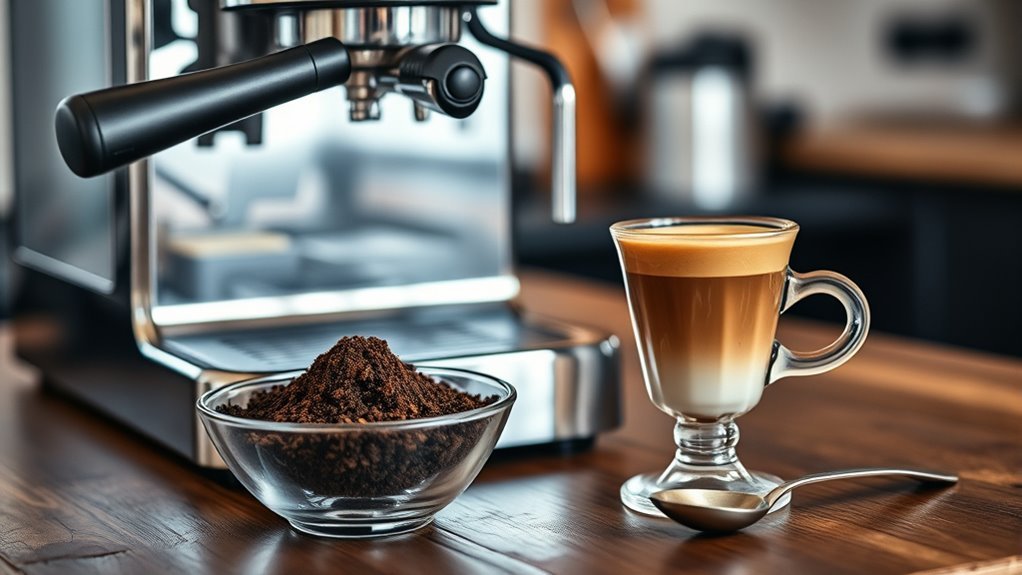
When experimenting with blends and ratios, you’ll find that the combination of different coffee types can greatly enhance the flavor profile of your espresso. Start by selecting base coffee blends that offer distinct characteristics—like a bold Arabica paired with a chocolatey Robusta. Adjust the ratio of these beans to discover a balance that suits your palate; for instance, a 70:30 Arabica to Robusta mix may yield a rich crema with vibrant taste notes. Keep track of your ratio experimentation, noting how each blend affects the aroma, body, and aftertaste. This process not only allows for customized flavors but also encourages an exploration of the artistry behind espresso brewing, giving you the freedom to create a cup that’s uniquely yours.
Cleaning and Maintenance Considerations
When using regular coffee grounds in your espresso machine, you may notice an increase in residue buildup. This can lead to accelerated wear on machine components, demanding more frequent cleaning. To maintain peak performance, you’ll need to adjust your cleaning routine accordingly.
Regular Grounds Residue
After using regular coffee grounds in your espresso machine, it’s essential to address the residue left behind. Regular grounds can lead to significant residue buildup, which may affect your machine’s performance and the flavor of your espresso. To maintain peak functionality, you should regularly clean the brew group, portafilter, and water reservoir. Use specialized cleaning solutions designed for espresso machines to effectively remove oily residues and coffee particles. A soft brush can help dislodge stubborn buildup in hard-to-reach areas. Additionally, run a few water-only cycles to flush out any remaining residue. By prioritizing this cleaning routine, you’ll guarantee your espresso machine continues to deliver the rich, robust flavors you love, without the interference of leftover coffee grounds.
Machine Component Wear
Although using regular coffee grounds can enhance your espresso experience, it can also lead to increased wear on your machine’s components if not properly maintained. Regular grounds may clog filters and damage internal parts, ultimately affecting machine longevity. To prevent wear, consider the following factors:
| Component | Impact of Regular Grounds |
|---|---|
| Pump | Increased strain and potential failure |
| Group Head | Clogging and uneven extraction |
| Filter Basket | Faster wear and reduced efficiency |
To guarantee wear prevention, always clean your machine thoroughly and monitor its performance. Prioritizing maintenance will not only prolong the lifespan of your espresso machine but also keep your coffee experience enjoyable. Remember, a well-cared machine is essential for consistent quality.
Cleaning Frequency Increase
As regular coffee grounds can lead to increased residue buildup, you’ll need to adjust your cleaning frequency to maintain peak performance of your espresso machine. The oils and fine particles in these grounds can clog ports and affect extraction quality. To counteract this, consider implementing a more rigorous maintenance schedule. Cleaning your machine after every use is ideal, but at a minimum, you should perform a thorough cleaning weekly if you’re using regular coffee grounds. This includes backflushing, descaling, and inspecting components for wear. By increasing your cleaning frequency, you’ll not only extend the lifespan of your machine but also guarantee that every shot of espresso you brew is rich and flavorful, aligning with your desire for freedom in crafting perfect coffee.
Final Thoughts on Brewing With Regular Coffee Grounds
While many coffee enthusiasts swear by specialty blends for their espresso machines, brewing with regular coffee grounds can yield satisfying results if approached thoughtfully. By carefully selecting your coffee types and understanding the nuances of brewing techniques, you can create a robust shot that rivals traditional espresso. Start with a medium grind size, as it balances extraction and flavor. Experiment with water temperature and brew time to optimize your results. Remember, regular coffee grounds might have different flavor profiles compared to specialty beans, so be prepared for variations in taste. Ultimately, embracing this approach can empower you to explore your coffee preferences without breaking the bank, granting you the freedom to enjoy a rich espresso experience in your own way.
Frequently Asked Questions
Can I Use Flavored Coffee Grounds in an Espresso Machine?
You can absolutely use flavored coffee grounds in an espresso machine, but keep in mind that the espresso extraction process may alter the flavor profile compared to regular beans. The oils and additives in flavored coffee could affect your machine’s performance over time, so it’s essential to clean it regularly. If you enjoy experimenting, flavored coffee can yield interesting results, but make sure you’re using a quality grind for the best espresso experience.
Will Regular Coffee Grounds Damage My Espresso Machine?
You might think using regular coffee grounds won’t impact your espresso machine, but it can actually affect its performance and maintenance. Regular coffee grounds are often coarser, which can lead to clogging and reduced pressure. This incompatibility could cause wear over time, requiring more frequent maintenance or even repairs. To keep your espresso machine in top shape, it’s best to use finely ground coffee that’s specifically designed for espresso brewing.
How Much Coffee Should I Use for a Single Shot?
For a single shot of espresso extraction, you should use about 7 to 9 grams of finely ground coffee. This precise amount guarantees ideal pressure and flavor during extraction. The grind size is vital; too coarse won’t extract properly, while too fine can lead to over-extraction and bitterness. Experimenting within this range can help you find your ideal taste, granting you the freedom to customize your espresso experience to your liking.
Can I Mix Espresso Grounds With Regular Coffee Grounds?
Mixing espresso grounds with regular coffee grounds is like blending two distinct musical genres; it can create something unique, but harmony is key. Espresso blends are crafted for fine grind size, while regular grounds vary in coarseness. When mixed, the resulting brew may lack the ideal flavor and extraction you crave. For the best taste experience, stick to using grounds that match your machine’s requirements, ensuring your coffee symphony hits all the right notes.
Is It Safe to Reuse Coffee Grounds in an Espresso Machine?
Reusing grounds in an espresso machine isn’t recommended if you want peak brewing quality. When you reuse coffee grounds, you’ll likely extract less flavor and aroma, resulting in a subpar cup. The oils and compounds that contribute to the taste are mostly depleted after the first brew. To maintain that rich, bold flavor you crave, it’s best to stick with fresh grounds for each shot. Your taste buds will thank you for it!
